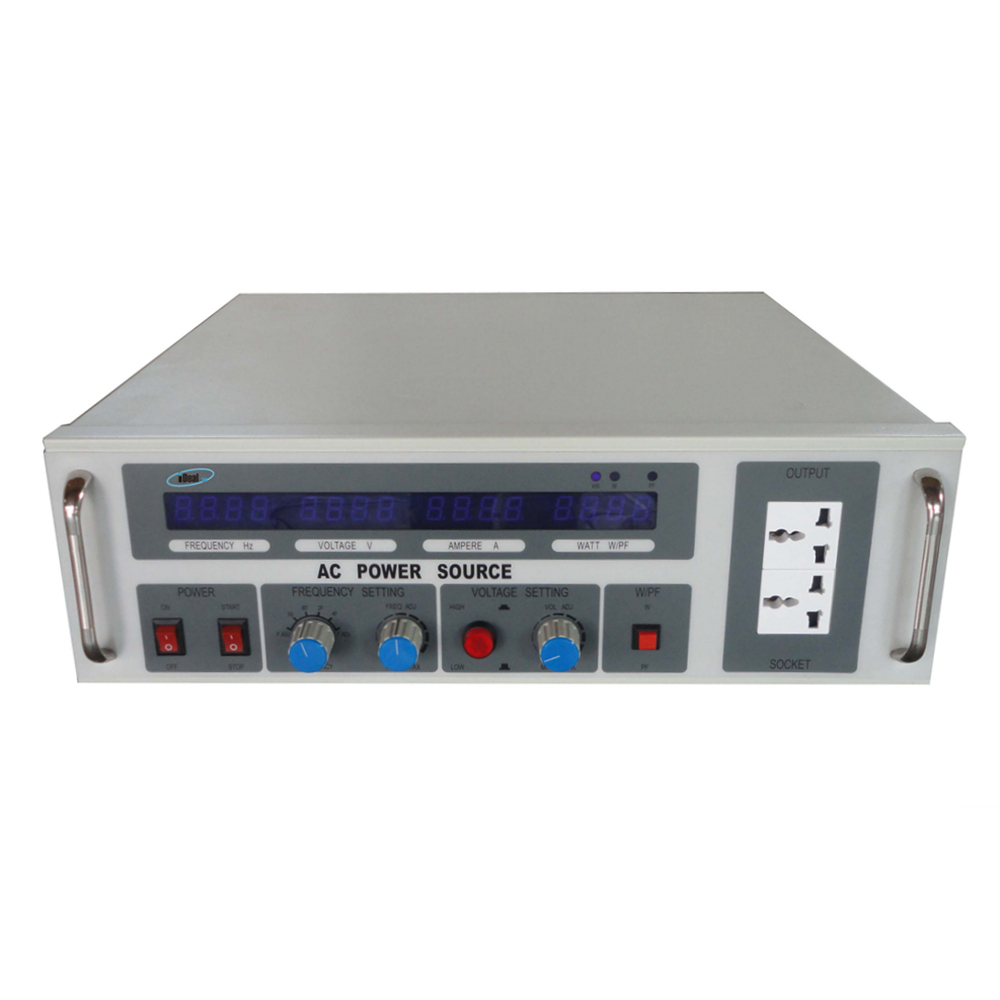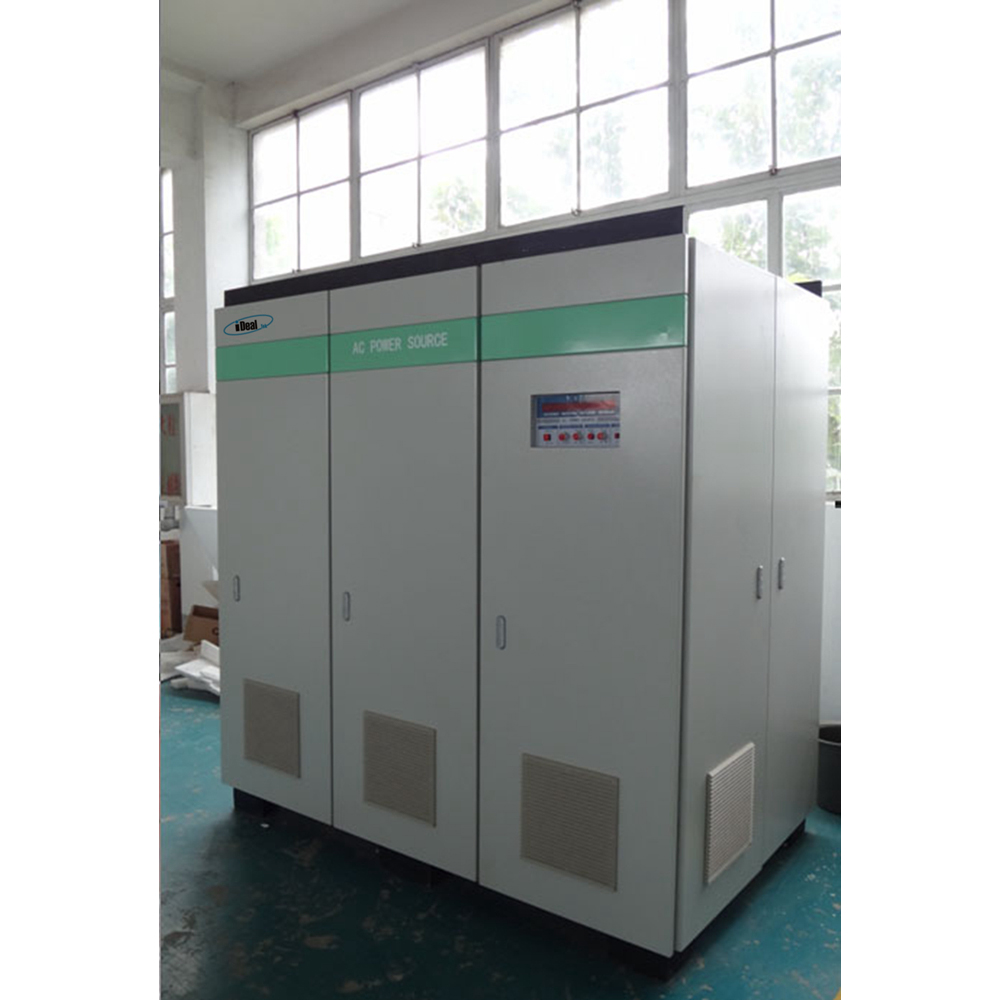Variable Frequency AC Power Supplies The VFP series AC Power Supplies are high precision, high efficiency, low THD adjustable AC power supplies that converts the input mains power through AC→DC→AC conversion, and gives a pure sine wave AC output with adjustable voltage & frequency within a certain range. Also known as Variable Frequency AC Power Source.
Variable Frequency AC Power Supplies, AC Variable Frequency Power Supplies, Variable Frequency AC Power Sources, Variable Frequency Power Supplies, Variable Frequency Power Sources Yangzhou IdealTek Electronics Co., Ltd. , https://www.idealtekpower.com


According to the difference in the number of output phases, it can be divided into single-phase and three-phase AC power supplies.
The output power of single-phase adjustable AC power supply ranges from 500VA to 200KVA, the output power of three-phase adjustable AC power supply ranges from 3KVA to 600KVA, the output voltage is divided into 0 ~ 150Vac, 150 ~ 300Vac, and the output frequency is adjustable from 45Hz to 70Hz with 50/60Hz fixed frequency output.
Through the friendly operation panel, you can read the output data such as output voltage, output current, output power, power factor, etc., providing accurate data records for your test, and can add RS485 interfaces as standard, following the MODBUS-RTU international communication protocol, which can realize remote control and operating status monitoring of the power supplies.
This series of adjustable AC Power Supplies have comprehensive protection functions, such as: over voltage, over current, over temperature and short circuit protections, which can protect the AC power supplies and DUT from damages. At present, it is mainly used for Various electrical appliance manufacturers conduct grid simulation tests on electrical appliances according to the voltage/frequency requirements of different countries. Imported electrical appliances are used for the domestic demand for variable voltage and frequency conversion, as well as various AC motors and AC transformers.
"Who said that charging has to be connected by a wire? Just let your phone and charger 'sense each other'—and you can charge it! Let’s explore the principle behind 'wireless charging'!
Every time you want to charge your phone, laptop, or other electronic devices, you always have to grab a cable. With so many cables around, it's easy to mix them up and get frustrated. But now, more and more gadgets are using wireless charging technology! All you need to do is place your phone on a small, cup-shaped pad, and it charges without any wires. How does this amazing technology work? Let’s dive in together.
[Image: Wireless charging pad with a smartphone on top]
**Electrical and Magnetic Interaction**
The most common form of wireless charging uses the "current magnetic effect" and "electromagnetic induction." In 1819, Danish scientist Hans Christian Ørsted discovered that when current flows through a wire, a magnetic field forms around it, which can affect a compass needle. Later, scientists found that if the wire is shaped into a loop or coil, the magnetic field becomes stronger and more concentrated—this is known as the "current magnetic effect."
Then came electromagnetic induction, discovered by Michael Faraday in 1831. He found that when a magnet or changing magnetic field is placed near a coil without current, it induces a current in the coil. This is called "electromagnetic induction." Importantly, for this to happen, the magnetic field must be changing—like moving closer or farther away. If the field stays constant, no current is induced.
In short, the current magnetic effect creates a magnetic field from electric current, while electromagnetic induction uses a changing magnetic field to generate current in a coil.
[Image: Diagram of electromagnetic induction]
**How Electromagnetic Induction Works for Charging**
These two principles are used together in wireless charging. A typical wireless charging pad contains a coil. When plugged in, the current flowing through the coil generates a magnetic field (current magnetic effect). The device being charged also has a coil inside. When it's placed near the pad, the changing magnetic field from the pad induces a current in the device’s coil via electromagnetic induction. That current then charges the battery.
You might wonder: if the distance between the pad and the device doesn’t change, how does the magnetic field keep changing? The answer lies in the power source. The electricity from the wall is alternating current (AC), which constantly changes direction. This causes the magnetic field to fluctuate, satisfying the condition for electromagnetic induction.
Recently, more smartphones and tablets have started supporting wireless charging. However, even with the latest tech, the charging range is still limited—usually less than 5 cm. Most devices need to be placed flat on the charging pad, and there's still some gap in efficiency compared to wired charging.
[Image: Close-up of wireless charging pad]
**Using Resonance to Increase Charging Distance**
To improve both distance and efficiency, scientists are exploring "magnetic resonance" for wireless charging. By adding components like capacitors and inductors, they create a "resonant circuit." Think of it like a tuning fork: once struck, it vibrates for a while. Similarly, a resonant circuit can sustain energy after being briefly energized.
Tuning forks resonate at specific frequencies. If another fork with the same frequency is nearby, it will vibrate too—even without direct contact. This is resonance, and it allows energy transfer. In wireless charging, two resonant circuits with the same frequency can exchange energy through space. This method can extend the charging distance to several meters and improve efficiency. The challenge is keeping both circuits tuned to the same frequency over time.
Besides resonance, some researchers are experimenting with laser light or radio waves—similar to Wi-Fi—to transmit energy wirelessly. These advancements could one day make charging even more convenient and seamless.
[Image: Diagram of magnetic resonance charging system]
August 02, 2025